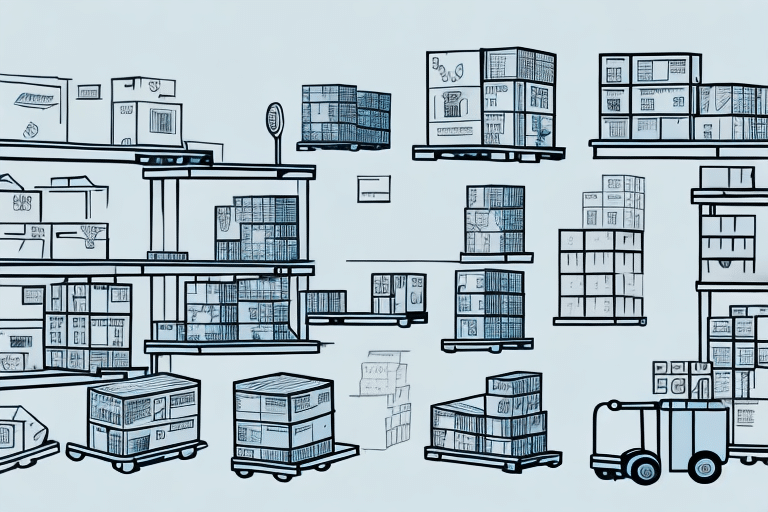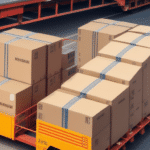What Inbound Logistics Include
Inbound logistics is a fundamental component of supply chain management, encompassing the processes involved in receiving, storing, and distributing raw materials and other goods from suppliers to production facilities or warehouses. The primary objectives of efficient inbound logistics include reducing lead times, minimizing inventory costs, and enhancing the overall quality of goods. This article delves into the fundamentals of inbound logistics, explores its benefits, key components, the role of technology, best practices, challenges, metrics for success, real-world case studies, and future trends in the field.
Understanding the Basics of Inbound Logistics
At the core of inbound logistics is the meticulous mapping of the supply chain. This involves identifying all suppliers, the materials they provide, and the frequency and reliability of deliveries. According to a Supply Chain Digital report, effective supply chain mapping can improve supply chain visibility by up to 30%, enabling businesses to forecast demand more accurately.
Transportation management is another critical aspect, encompassing the selection of efficient transportation modes—such as trucking, rail, or maritime shipping—to balance cost and speed. For instance, the Bureau of Transportation Statistics reported that trucking accounts for approximately 70% of the nation’s freight transport by weight.
Furthermore, the integration of advanced technologies, including transportation management systems (TMS) and real-time tracking solutions, allows businesses to monitor the movement of materials in real-time, identify potential bottlenecks, and make data-driven adjustments to optimize the supply chain. This leads to increased efficiency and improved customer satisfaction by ensuring timely delivery of products.
Benefits of Efficient Inbound Logistics for Your Business
Efficient inbound logistics can yield significant benefits, including:
- Reduced Lead Times: Streamlined processes ensure materials arrive promptly, accelerating production cycles.
- Lower Inventory Costs: Optimized inventory levels reduce holding costs and minimize excess stock.
- Enhanced Product Quality: Reliable and consistent supply chains contribute to maintaining high product standards.
- Increased Customer Satisfaction: Timely and accurate deliveries foster customer loyalty and repeat business.
- Better Resource Management: Effective planning and forecasting enable businesses to allocate resources more efficiently.
- Stronger Supplier Relationships: Collaborative logistics strategies enhance communication and trust with suppliers.
According to a McKinsey report, companies with highly efficient supply chains enjoy up to 15% higher profitability compared to their peers.
Key Components of Successful Inbound Logistics Operations
Successful inbound logistics operations are built upon five key components:
- Sourcing: Identifying and selecting reliable suppliers who can deliver quality materials consistently.
- Transportation: Efficiently moving materials from suppliers to the production site or warehouses.
- Warehousing: Storing materials securely and managing inventory effectively.
- Inventory Management: Maintaining optimal inventory levels to meet production needs without overstocking.
- Information Technology: Utilizing systems and software to track, manage, and optimize logistics operations.
Effective Communication and Collaboration
Effective communication and collaboration among suppliers, transportation providers, warehouse staff, and production teams are essential. By fostering strong relationships and sharing pertinent information, businesses can preemptively address potential issues, minimize disruptions, and enhance overall operational efficiency.
The Role of Technology in Streamlining Inbound Logistics
Technology plays a pivotal role in optimizing inbound logistics through:
- Real-Time Tracking: Tools like GPS tracking and IoT devices provide real-time visibility into shipment locations and statuses, enabling proactive management.
- Automated Inventory Management Systems: Software solutions automate inventory tracking, reducing human error and ensuring accurate stock levels.
- Route Optimization Software: Advanced algorithms determine the most cost-effective and time-efficient routes for transportation, reducing fuel consumption and delivery times.
For example, IBM's blockchain technology enhances supply chain transparency and security by providing immutable records of transactions and movements.
According to a Software Advice report, 61% of businesses now use some form of supply chain management software to improve inbound logistics efficiency.
Best Practices for Effective Inbound Logistics Management
Implementing best practices in inbound logistics management can significantly enhance operational performance:
- Establish Robust Communication Channels: Maintain open lines of communication with suppliers and logistics partners to ensure transparency and quick resolution of issues.
- Optimize Transportation Routes: Utilize route planning tools to minimize transit times and reduce transportation costs.
- Inventory Optimization: Implement just-in-time (JIT) inventory practices to align inventory levels closely with production schedules.
- Invest in Advanced Technology: Adopt technologies such as TMS, ERP systems, and automation tools to enhance operational efficiency.
- Monitor and Analyze Performance Metrics: Regularly track key performance indicators (KPIs) to identify areas for improvement and implement necessary changes.
- Foster Cross-Departmental Collaboration: Encourage cooperation among procurement, production, and warehousing teams to ensure seamless logistics operations.
Consistent application of these best practices can lead to substantial improvements in inbound logistics efficiency and overall business performance.
Top Challenges Faced in Implementing Inbound Logistics Strategies
Despite its benefits, businesses often encounter challenges when implementing inbound logistics strategies:
- Poor Supplier Communication: Lack of effective communication can lead to misunderstandings, delays, and quality issues.
- Inadequate Technology Infrastructure: Without the right technological tools, managing and optimizing inbound logistics becomes cumbersome.
- Insufficient Personnel Training: Employees may struggle to utilize advanced systems effectively if not properly trained.
- Supply Chain Disruptions: Unexpected changes in market demand or supplier capabilities can disrupt the logistics process.
- Lack of Supply Chain Visibility: Limited real-time data impedes the ability to make informed decisions and optimize the supply chain.
To address these challenges, businesses should invest in comprehensive supply chain visibility tools, enhance communication with suppliers, and provide continuous training to personnel. Collaboration with reputable partners and adopting flexible logistics strategies can also mitigate potential disruptions.
How to Measure the Success of Your Inbound Logistics Efforts
Measuring the success of inbound logistics involves evaluating key performance indicators (KPIs) aligned with business objectives:
- Delivery Performance: Assess on-time delivery rates and the reliability of suppliers.
- Inventory Levels: Monitor inventory turnover rates and stockout frequencies.
- Lead Times: Evaluate the time taken from order placement to receipt of goods.
- Cost Efficiency: Analyze total logistics costs, including transportation, warehousing, and inventory holding costs.
- Customer Satisfaction: Measure metrics such as order accuracy, delivery speed, and product quality.
Regular analysis of these KPIs enables businesses to identify inefficiencies, implement corrective measures, and enhance overall inbound logistics performance. Furthermore, benchmarking against industry standards can provide insights into areas requiring improvement.
Case Studies: Successful Inbound Logistics Strategies Implemented by Top Companies
Amazon
Amazon has revolutionized inbound logistics through its sophisticated Fulfillment by Amazon (FBA) system, which leverages advanced inventory management and automation technologies. By optimizing its transportation networks and utilizing real-time data analytics, Amazon ensures rapid and accurate deliveries to customers worldwide.
Toyota
Renowned for its Just-In-Time (JIT) inventory system, Toyota minimizes inventory levels and reduces waste by receiving goods only as they are needed in the production process. This approach enhances efficiency and responsiveness, allowing Toyota to maintain high standards of quality and flexibility.
Walmart
Walmart employs a cross-docking strategy, which involves transferring products directly from inbound to outbound transportation without long-term storage. This method reduces inventory holding costs and accelerates the movement of goods, enabling Walmart to offer competitive pricing and maintain high inventory turnover.
Coca-Cola
Coca-Cola utilizes a vendor-managed inventory (VMI) system, wherein suppliers manage the inventory levels at Coca-Cola's distribution centers. This collaborative approach ensures timely replenishment of stock, reduces inventory costs, and improves supply chain efficiency.
These case studies demonstrate how leading companies implement innovative inbound logistics strategies to enhance efficiency, reduce costs, and achieve competitive advantage in their respective industries.
Future Trends and Innovations in the Field of Inbound Logistics
The landscape of inbound logistics is continually evolving, driven by technological advancements and changing market dynamics. Key future trends and innovations include:
- Blockchain Technology: Blockchain can enhance supply chain transparency and security by providing immutable records of transactions and movements, reducing fraud and errors.
- Artificial Intelligence (AI) and Machine Learning: AI-powered tools can optimize logistics operations by predicting demand, optimizing routes, and automating decision-making processes.
- Autonomous Delivery Vehicles: Autonomous drones and self-driving trucks have the potential to revolutionize last-mile delivery, reducing costs and improving delivery speeds.
- 3D Printing: On-demand manufacturing enables businesses to produce parts and components as needed, reducing the need for large inventories and minimizing lead times.
- Sustainable Logistics: Growing emphasis on sustainability is driving the adoption of eco-friendly practices, such as electric vehicles and optimized routing to reduce carbon footprints.
For instance, companies like Anheuser-Busch are exploring the use of 3D printing for producing packaging components, while firms like Uber ATG are developing autonomous delivery solutions.
Embracing these trends and innovations will be crucial for businesses aiming to stay competitive and meet the evolving demands of the marketplace.
In conclusion, an effective inbound logistics process is essential for reducing lead times, minimizing inventory costs, and enhancing product quality. By leveraging key components, adopting best practices, integrating advanced technologies, and staying abreast of future innovations, businesses can optimize their inbound logistics operations and maintain a competitive edge.




















